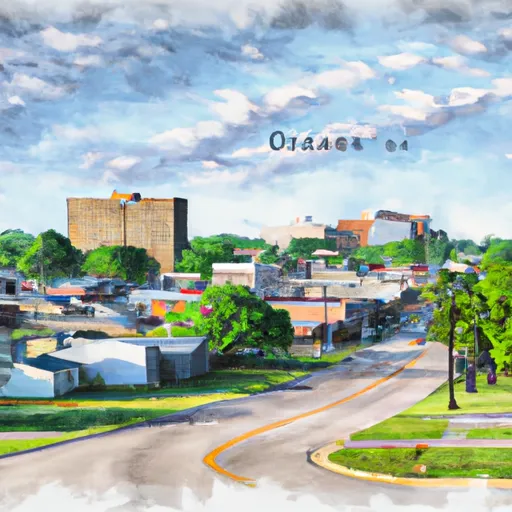-
 Snoflo Premium
Snoflo Premium
Get unlimited access to all our content
With no Ad interruptions! - Start Your Free Trial Login with existing account
O-Kean
Eden Index
Climate
8.1
•
Recreation
4.2
•
Community
•
Safeguard
4.7/10

O-Kean, Arkansas is a small town located in the northeastern part of the state. It experiences a humid subtropical climate with hot summers and mild winters. The region receives an average annual rainfall of around 50 inches and can occasionally face severe weather, including thunderstorms and tornadoes.
Hydrologically, O-Kean is situated near the Black and Cache Rivers, providing opportunities for fishing, boating, and other water sports. These rivers are known for their diverse aquatic wildlife, making it an ideal location for nature enthusiasts and anglers.
Outdoor recreation opportunities in O-Kean also include exploring the nearby St. Francis National Forest. This forest offers hiking trails, camping sites, and hunting opportunities for various game species. With its natural beauty and diverse outdoor activities, O-Kean provides a charming destination for those seeking adventure in Arkansas.
What is the Eden Index?
The Snoflo Eden Index serves as a comprehensive rating system for regions, evaluating their desirability through a holistic assessment of climate health, outdoor recreation opportunities, and natural disaster risk, acknowledging the profound impact of these factors on livability and well-being.
Climate Health Indicator (CHI): 8.1
O-Kean receives approximately
1223mm of rain per year,
with humidity levels near 81%
and air temperatures averaging around
16°C.
O-Kean has a plant hardyness factor of
7, meaning
plants and agriculture in this region tend to thrive during the non-winter months.
By considering the ideal temperature range, reliable water supplies, clean air, and stable seasonal rain or snowpacks, the Climate Health Indicator (CHI) underscores the significance of a healthy climate as the foundation for quality living.
A healthy climate is paramount for ensuring a high quality of life and livability in a region, fostering both physical well-being and environmental harmony. This can be characterized by ideal temperatures, reliable access to water supplies, clean air, and consistent seasonal rain or snowpacks.
Weather Forecast
Streamflow Conditions
Lower White
Area Rivers
Lower White
Snowpack Depths
Lower White
Reservoir Storage Capacity
Lower White
Groundwater Levels
Recreational Opportunity Index (ROI): 4.2
The Recreational Opportunity Index (ROI) recognizes the value of outdoor recreational options, such as parks, hiking trails, camping sites, and fishing spots, while acknowledging that climate plays a pivotal role in ensuring the comfort and consistency of these experiences.
Access to outdoor recreational opportunities, encompassing activities such as parks, hiking, camping, and fishing, is crucial for overall well-being, and the climate plays a pivotal role in enabling and enhancing these experiences, ensuring that individuals can engage in nature-based activities comfortably and consistently.
Camping Areas
| Campground | Campsites | Reservations | Toilets | Showers | Elevation |
|---|---|---|---|---|---|
| Tickfaw State Park | None | 15 ft | |||
| South Recreation Composite | 100 | 140 ft | |||
| Clear Spgs Rec Area | 45 | 317 ft | |||
| Rocky Springs - Natchez Trace Pkwy | 22 | 235 ft | |||
| Lamar Dixon Expo RV Center | 300 | 11 ft | |||
| Little Sunflower River | None | 107 ft | |||
| Float Camp | 16 | 472 ft | |||
| North Rec Composite | 15 | 97 ft | |||
| Lake Charlie Capps | None | 146 ft | |||
| Leroy Percy State Park | None | 108 ft |
Nearby Ski Areas
Catastrophe Safeguard Index (CSI):
The Catastrophe Safeguard Index (CSI) recognizes that natural disaster risk, encompassing floods, fires, hurricanes, and tornadoes, can drastically affect safety and the overall appeal of an area.
The level of natural disaster risk in a region significantly affects safety and the overall livability, with climate change amplifying these risks by potentially increasing the frequency and intensity of events like floods, fires, hurricanes, and tornadoes, thereby posing substantial challenges to community resilience and well-being.
Community Resilience Indicator (CRI):
The Community Resilience Indicator (CRI) recognizes that education, healthcare, and socioeconomics are crucial to the well-being of a region. The CRI acknowledges the profound impact of these elements on residents' overall quality of life. By evaluating educational resources, healthcare accessibility, and economic inclusivity, the index captures the essential aspects that contribute to a thriving community, fostering resident satisfaction, equity, and social cohesion.

